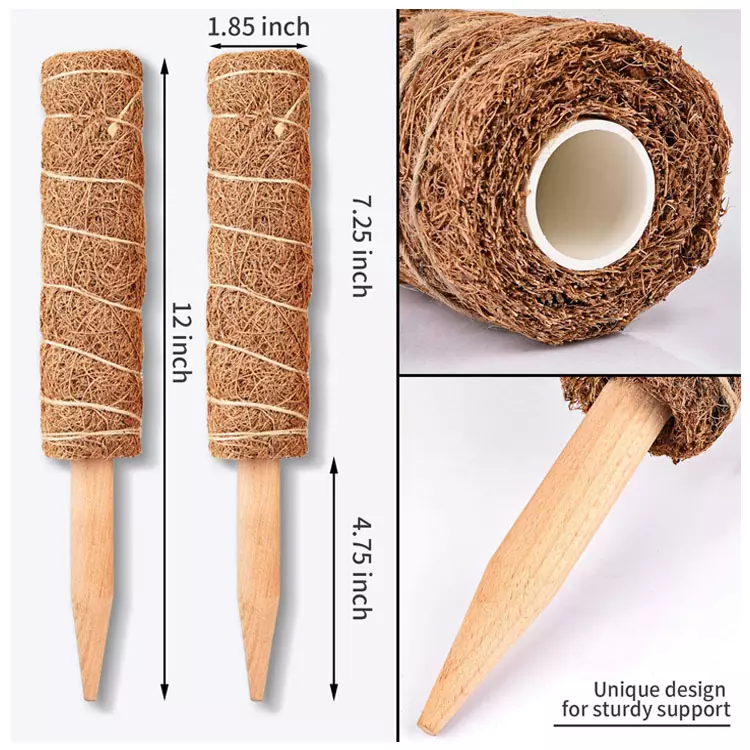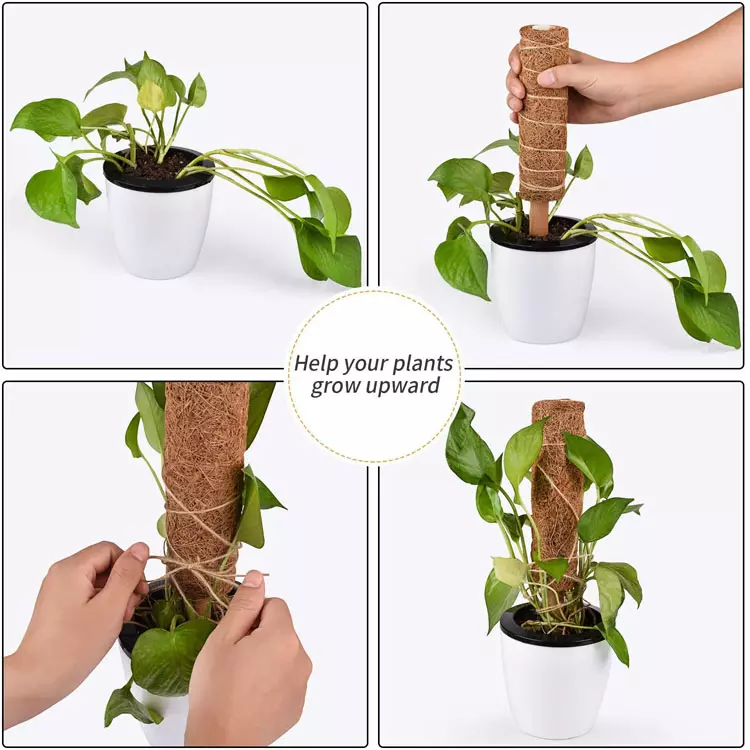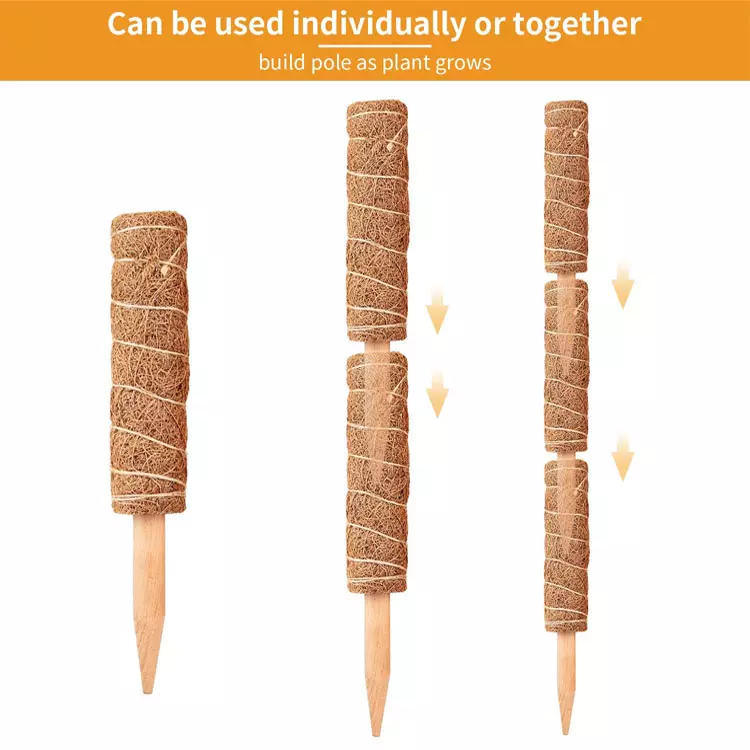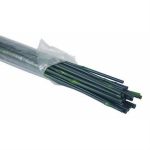Coir Totem Poles Plant Support
$3.99
Plant Support
Discount per quantity
| Quantity | 3 - 8 | 9 - 14 | 15+ |
|---|---|---|---|
| Price | $3.87 | $3.75 | $3.59 |
| % Discount | 3% | 6% | 10% |
10 in stock
Description
Coir Totem Poles: The Gentle Giant That Helps Our Plants Climb
Welcome to the World of Natural Support
Picture a soft, brown pole standing tall in your favorite pot. Fibers made from coconut husk wrap around it like a warm sweater. Roots grip and leaves stretch higher each day. That, friend, is a coir totem pole. In other words, it is a simple tool that invites vines and aroids to grow the way they would in the wild—upward, strong, and happy. But most of all, it gives us an easy way to turn a plain houseplant into living art.
In the next several pages, we will walk step-by-step through everything you need to know. We will explore what coir poles are, how they work, and why they stand out from other supports. We will also dive into care, troubleshooting, and fun ideas that spark fresh creativity. By the end, you and your plants will both feel ready to reach new heights.
What Is a Coir Totem Pole?
A coir totem pole is a sturdy, stick-like support wrapped in coconut coir fibers. The center can be PVC, bamboo, or recycled wood. The outside cover is the star. Coir fibers come from the husk of coconuts—natural, renewable, and kind to the earth. The rough surface offers many tiny ridges. Roots grip these ridges, cling tight, and sip moisture locked inside the fiber.
Three Key Traits
- Moisture-Holding – Coir soaks up water like a sponge. It keeps aerial roots from drying out.
- Root-Friendly Texture – Instead of slick plastic or sharp wire, the fibrous mat feels gentle yet grippy.
- Lightweight Strength – Even tall poles do not weigh down a pot. You can move plants without strain.
Think of the pole as a ladder in the forest. Each rung invites a new leaf, bigger and bolder than the last. Instead of sprawling sideways and hogging table space, vines move up, saving room and showing off their true form.
Why Choose Coir Over Other Supports?
1. It Respects Nature
Many gardeners love moss poles. Yet harvesting wild sphagnum moss can harm wetlands. Coir comes from coconuts already grown for food and oil. Using the husk turns waste into treasure. We reduce pressure on fragile peat lands, and that matters.
2. It Holds Water Longer
Wire cages and plain bamboo stakes stay dry. Roots that touch them desiccate and fail. Coir, in contrast, wicks water along its length. Plants drink slowly throughout the day. In other words, a coir pole becomes a built-in moisture bar.
3. It Lasts Season After Season
Wood stakes can rot. Metal stakes can rust. Coir poles resist both. The inner core stays firm, while the fiber shell breaks down very, very slowly. Most poles serve three to five years before a refresh is needed.
4. It Encourages Bigger Leaves
Many tropical plants form larger foliage only when they can climb. Philodendron, Monstera, and Epipremnum all produce mature leaves once they feel secure. A coir pole triggers this instinct. Instead of small juvenile leaves, you may see splits, perforations, and richer color.
5. It Fits Any Decor
Brown fiber blends with soil and pot. It feels warm, earthy, and neutral. Whether your home style is sleek modern or rustic cottage, the pole looks natural. No bright green plastic in sight.
After more than one season, the rewards become clear. Plants are healthier, rooms feel livelier, and our own joy in caring for them grows.
Anatomy of a Coir Pole
| Part | Purpose | Care Tip |
|---|---|---|
| Core | Provides rigid spine. Often PVC, bamboo, or reclaimed wood. | Keep sealed ends off wet saucers to avoid rot. |
| Coir Fiber Wrap | Offers rough, moist surface for roots to grab. | Mist lightly every few days. |
| Plastic or Metal Pins | Hold fiber in place. | Check pins each quarter; press back if loose. |
| Extension Slot or Insert | Lets you stack another section when your plant outgrows height. | Plan ahead; buy matching brand for perfect fit. |
Instead of guessing what hides inside, now you know how each piece works together.
Picking the Perfect Pole for Your Plant
Measure First
Grab a ruler or tape. Measure from soil level to just above the tallest healthy leaf. Add six inches. That is your ideal starting height. Beginning taller than needed encourages upward growth without delay.
Match Thickness
Small pots under six inches wide need skinny poles. A thick post can crowd roots and trap water. For large floor plants, choose a wider core so the pole does not wobble.
Check Fiber Quality
Run your fingers along the wrap. Fiber should feel coarse yet springy, not dusty or brittle. Rich brown color shows it is fresh, not bleached.
Think About Extensions
Some poles screw together like toy blocks. Buying a set with future growth in mind saves money later. Instead of repotting each year, you simply add another tier.
Budget and Brand
You will find many options online and in garden centers. Price often reflects fiber density and core material. PVC cores cost less but may bend under very heavy vines. Bamboo costs more yet brings natural charm. Pick what feels right for your space and wallet.
How to Install Your Coir Pole
- Soak the Pole
Place the pole in a tub of water for 20–30 minutes. Fully soaked fiber holds shape and gives roots moisture from day one. - Prepare the Pot
Water the plant lightly so soil stays together. If you plan to repot, set fresh soil in the new container first. - Insert with Care
Hold the pole at an angle. Slide it down the side of the root ball, not through the center. Push until the core touches bottom of the pot. Packed soil around it should feel tight. - Tie the Vines
Use soft plant ties, cotton twine, or strips of old T-shirt. Loop once around the stem and lightly secure to the fiber. Do not strangle! Stems need room to thicken. - Mist and Settle
Spray the entire pole with water. Pack extra soil if small gaps form. Wipe leaves clean to remove displaced dirt. - Place in Bright, Gentle Light
After more than a week, the plant will latch on with new aerial roots. You may remove most ties then.
Instead of rushing, move slow. Each step builds trust between plant and support.
Routine Care and Long-Term Love
Daily or Weekly Mist
Gently mist the pole until fiber is damp but not dripping. If your home is very dry, daily misting helps. In humid rooms, twice a week is enough.
Monthly Deep Watering
Tilt the pot in a sink or tub. Pour water over the top of the pole so it runs down the fiber. This flushes dust and salts while rehydrating the core.
Fertilize Lightly
Dissolve a balanced liquid fertilizer at half strength. Feed the soil, not the pole. Too much fertilizer can leave crust on the fiber and burn tender roots.
Rotate for Even Growth
Turn the pot a quarter turn every two weeks. Leaves will face light evenly. The stem will wrap the pole in a graceful spiral rather than leaning hard in one direction.
Dust and Prune
Wipe leaves with a soft cloth. Trim any dead or yellow growth. Healthy airflow lowers risk of mold on damp fiber.
Watch for Pests
Mealybugs and scale love cozy crevices. Inspect once a week. If you find invaders, dab with cotton swabs dipped in isopropyl alcohol.
Care is simple, yet staying consistent brings dramatic results. Instead of sprawling on shelves, vines lift skyward in neat, lush columns.
When and How to Replace or Extend
After two or three years, the outer fiber may thin. Roots might poke through like busy explorers. If the core is firm, you can add a fresh layer of coir sheet around it. Wrap tightly and pin again.
If your plant is as tall as you are, consider stacking an extension. Most ready-made poles use either metal pegs or inner sleeves. Dampen the new pole, press until snug, then tie upper vines to the new surface.
Sometimes the whole pole feels wobbly or rotten. In that case, start over. Unwind ties, trim roots that cling too deeply, and slide in a new pole next to the old. Roots will migrate over within weeks.
The Best Plant Partners
| Plant Friend | Why It Loves a Coir Pole |
|---|---|
| Monstera deliciosa | Large fenestrated leaves appear sooner on a moist, vertical pole. |
| Philodendron ‘Burle Marx’ | Stays compact yet full when allowed to climb. |
| Epipremnum aureum (Pothos) | Leaves triple in size with strong support. |
| Syngonium podophyllum | Mature arrow leaves form on an upright stem. |
| Rhaphidophora tetrasperma | Tiny splits become big windows in higher light and height. |
| Hoya australis | Waxy vines wrap the pole, then flower close to eye level. |
| Cissus discolor | Velvet purple leaves show deeper hues on moist fiber. |
Many other climbers, including vanilla orchids and rhipsalis, join the list. In short, if the plant sends out aerial roots, a coir pole will feel like home.
Creative Uses Beyond Vines
- Mini Jungle Wall – Line three or four poles in one large trough. Train multiple species together for a vertical garden.
- Living Room Divider – Tall floor pots topped with poles can form a green screen. Instead of plastic partitions, you gain fresh air and beauty.
- Herb Tower – Stack coir columns filled with potting mix. Plant trailing herbs, such as thyme and oregano, around each layer. Harvest is easy and space efficient.
- Kids’ Science Project – Show root behavior by peeling back a small window of fiber and covering with clear plastic. Children watch roots grab and grow.
- Seasonal Decor – Wrap fairy lights around the pole during holidays. Soft twinkles highlight lush foliage without harm.
These ideas reveal that a humble pole can spark wide imagination.
Troubleshooting Common Issues
Pole Dries Out Too Fast
- Problem: Fiber feels crisp within hours.
- Fix: Wrap the pole with a thin layer of sphagnum moss under the coir. Raise room humidity with a pebble tray or humidifier.
Mold Appears on Fiber
- Problem: White fuzz grows after frequent misting.
- Fix: Improve airflow. Decrease misting frequency. Wipe mold with diluted hydrogen peroxide.
Plant Refuses to Cling
- Problem: Vines keep falling away.
- Fix: Use more ties at first. Score shallow X marks in the fiber to give roots places to anchor. Ensure the pole remains moist.
Pole Leans or Shifts
- Problem: Heavy top growth tips the pot.
- Fix: Press a bamboo stake opposite the lean and tie both together for stability. Consider a heavier clay pot.
Fiber Sheds on Floor
- Problem: Dry pieces flake off.
- Fix: Lightly mist before handling. Replace outer layer if fiber becomes brittle.
Instead of feeling discouraged, treat each issue as a small lesson. With patience, both you and your plant will adapt.
Growing Tall Together
Coir totem poles offer more than height. They reveal the hidden spirit of our plants—their wish to climb, mature, and greet the sun. When we give them natural, earth-friendly supports, they reward us with bigger leaves, stronger stems, and living sculptures that spark daily joy.
Now you know how to choose, install, and care for these gentle giants. You have learned handy fixes for bumps along the way and discovered fresh ideas for creative displays. So gather your pots, soak a pole, and let’s set the stage for lush new growth. Together, we rise.
Additional information
| Weight | 0.3 lbs |
|---|





